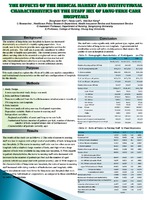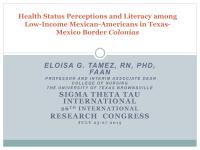| dc.contributor.author | Park, Jiyoung | en |
| dc.contributor.author | Kang, Chulhee | en |
| dc.contributor.author | Lee, Tae Wha | en |
| dc.contributor.author | Nam, Chung-Mo | en |
| dc.contributor.author | Lee, Ja-yin | en |
| dc.contributor.author | Kim, Hee Soon | en |
| dc.contributor.author | Lee, Hyeonkyeong | en |
| dc.date.accessioned | 2014-11-17T13:45:26Z | |
| dc.date.available | 2014-11-17T13:45:26Z | |
| dc.date.issued | 2014-11-17 | |
| dc.identifier | INRC14J03 | |
| dc.identifier.uri | http://hdl.handle.net/10755/335147 | |
| dc.description | <p>International Nursing Research Congress, 2014 Theme: Engaging Colleagues: Improving Global Health Outcomes. Held at the Hong Kong Convention and Exhibition Centre, Wanchai, Hong Kong</p> | en |
| dc.description.abstract | <p>Session presented on Sunday, July 27, 2014:</p>
<p><strong>Purpose: </strong>'Health disparity' is becoming a serious issue worldwide. The practice of health promoting behaviors (HPB) among childhood is influenced not only by individual factors but also by diverse environmental factors including family, peer relationship, school, and community organization. The purpose of this study was to investigate the ecological factors influencing HPB of children from low income families.</p>
<p><strong>Methods:</strong> Participants of the study included 297 fourth to sixth grade elementary school students from low-income families, 297 caregivers, and 68 community children center teachers. Data was collected by structured self-report survey, and a multi-level regression analysis was conducted.</p>
<p><strong>Results:</strong> The mean score of HPB of children was 3.16, and the highest point was in injury prevention whereas the lowest point was in exercise. The factors that influence HPB of children were as follows: self-efficacy and self-regulation among intrapersonal factors; caregivers health instruction behaviors and peer relationship among interpersonal factors; and the period of operation, perceived environments by children, and disabled children/teacher ratio among institutional factors.</p>
<p><strong>Conclusion:</strong> This study emphasized the importance of creating healthy environment for promoting health of children from vulnerable social groups and suggested that multi-level interventions would be more effective than interventions targeting a single level.</p> | en |
| dc.format | Text-based Document | en |
| dc.language.iso | en | en |
| dc.subject | Primary Prevention | en |
| dc.subject | Multi-Level Analysis | en |
| dc.subject | Health Status Disparities | en |
| dc.title | An ecological approach to understanding health promoting behaviors of children from low-income families: A multi-level analysis | en |
| dc.title.alternative | Health Promotion in the Pediatric Population | en |
| dc.type | Presentation | en |
| dc.rights.holder | <p>
All rights reserved by the author(s) and/or publisher(s) listed in this item record unless relinquished in whole or part by a rights notation or a Creative Commons License present in this item record.
</p><p>
All permission requests should be directed accordingly and not to the Sigma Repository.
</p><p>
All submitting authors or publishers have affirmed that when using material in their work where they do not own copyright, they have obtained permission of the copyright holder prior to submission and the rights holder has been acknowledged as necessary.
</p> | |
| dc.description.note | <p>Items submitted to a conference/event were evaluated/peer-reviewed at the time of abstract submission to the event. No other peer-review was provided prior to submission to the Henderson Repository.</p> | |
| dc.type.category | Full-text | en |
| dc.evidence.level | N/A | en |
| dc.research.approach | N/A | en |
| dc.contributor.department | Non-member | en |
| dc.author.details | Jiyoung Park, PhD, RN; Chulhee Kang, PhD; Tae Wha Lee, PhD, RN; Chung-Mo Nam, PhD; Ja-yin Lee, BS, RN; Hee Soon Kim, PhD, RN, FAAN; Hyeonkyeong Lee, PhD, RN | en |
| dc.conference.name | 25th International Nursing Research Congress | en |
| dc.conference.host | Sigma Theta Tau International | en |
| dc.conference.location | Hong Kong | en |
| dc.date.conferenceyear | 2014 | |
| dc.description.reviewtype | Abstract Review Only: Reviewed by Event Host | en |
| dc.description.acquisition | Proxy-submission | en |





